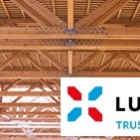In forestry, the concept of sustainability has been an accepted principle since the 18th century. Professor Jean-Luc Sandoz of the Ecole Polytechnique Fédérale de Lausanne spoke about the sustainable wood industry as an exemplary economic model at his recent visit to Luxembourg. He was invited by the Luxembourg association of private forest owners, whose goal is to increase the quality and quantity of forests while respecting sustainable exploitation.
“The very impetus for our modern concept of sustainability came from the forestry sector,” explains Philippe Genot, who recently joined Luxinnovation as the manager of the new Luxembourg Wood Cluster. “This is why the management of forests is a subject of universal interest.”
Wood is in fact the only major building material that is both renewable and sustainable over the long term. The use of wood in construction minimises the creation of solid waste and lessens the impact on air and water quality. Moreover, at the end of their life cycle, wood products can be used for energy or be disposed of without problems.
“In forestry, the concept of sustainability has been an accepted principle since the 18th century,” says Philippe. “For hundreds of years, wood had been a key resource for fuel and construction, particularly ships. With the realisation that forests were disappearing rapidly, people in countries around Europe came to understand that they needed to treat this important resource differently. Over time, the concept of sustainability – only harvesting what can be replaced by new growth – began to be used in other areas and applied to various industries and other economic models, its importance continually rising to the position it now holds in modern times.”
Wood evangelism
This historical concept is now, according to Professor Jean-Luc Sandoz of the Ecole Polytechnique Fédérale de Lausanne, a major hope for the future and an economic model for other sectors. In his keynote presentation at the yearly Forest Symposium organised by Lëtzebuerger Privatbësch, he pointed out that the recent history of global economics has been one of rampant growth and then collapse. The only way of avoiding the repetition of this scenario is to integrate strategic, long-term thinking into our use of global resources.
Professor Sandoz leads the team of the engineering offices of CBS (Concept Bois Structure in France)-CBT (and Concept Bois Technologie SA in St-Sulpice in Switzerland), which, after 20 years of research and teaching at the Ecole Polytechnique Fédérale de Lausanne, counts as one of most specialised bodies in the world on the topic of wooden construction. Wood is a versatile and efficient building material with an excellent thermal performance, low heat conductivity and good insulation properties. It is also the only carbon neutral construction material. Growing trees extract carbon dioxide from the atmosphere, and the carbon is stored inside forest products.
This ability to help overcome a major environmental challenge is essential to Professor Sandoz, who focussed his presentation on issues at a global level, namely that the planet is confronted with the ecological problem of global warming caused by greenhouse gases, including CO2. While forests and wood are part of the solution for handling CO2 emissions, Professor Sandoz pointed out that if they are sustainably managed and utilised as local resources for local construction that drive the local economy, they are also successful microcosmic examples – or exemplary economic models.
Local is good for global
Sandoz spoke passionately about building in local wood to restore the local circular economy. In his presentation he showed multiple examples of municipal buildings such as schools, and recreation centres that were realised in wood. Building in wood means using local carpenters who then order wood from the local sawyer who buys the wood from the regional foresters who cut the trees in the forests. The town therefore makes money that it can reinvest in maintenance of one of its other buildings or other requirements.
The theme of Sandoz’s talk was a perfect fit for the occasion. Luxembourg has a long tradition of conserving its scarce natural resources but it also must safeguard its human resources. In today’s global political context, it is vitally important to federate all of the various players in the wood sector more closely, to create more value locally and to prepare the sector to meet challenges in the short, medium and long term.
Support for the responsible use of this natural and sustainable wood resource and the valorisation of the know-how in Luxembourg and the Greater Region in order to develop the local economy and to conserve and even create jobs is paramount. It was precisely these drivers that led to a new cluster-type structure in Luxembourg – the Luxembourg Wood Cluster.
[ Mary CAREY - LUXINNOVATION.LU - Publié le 19/05/17 ]

